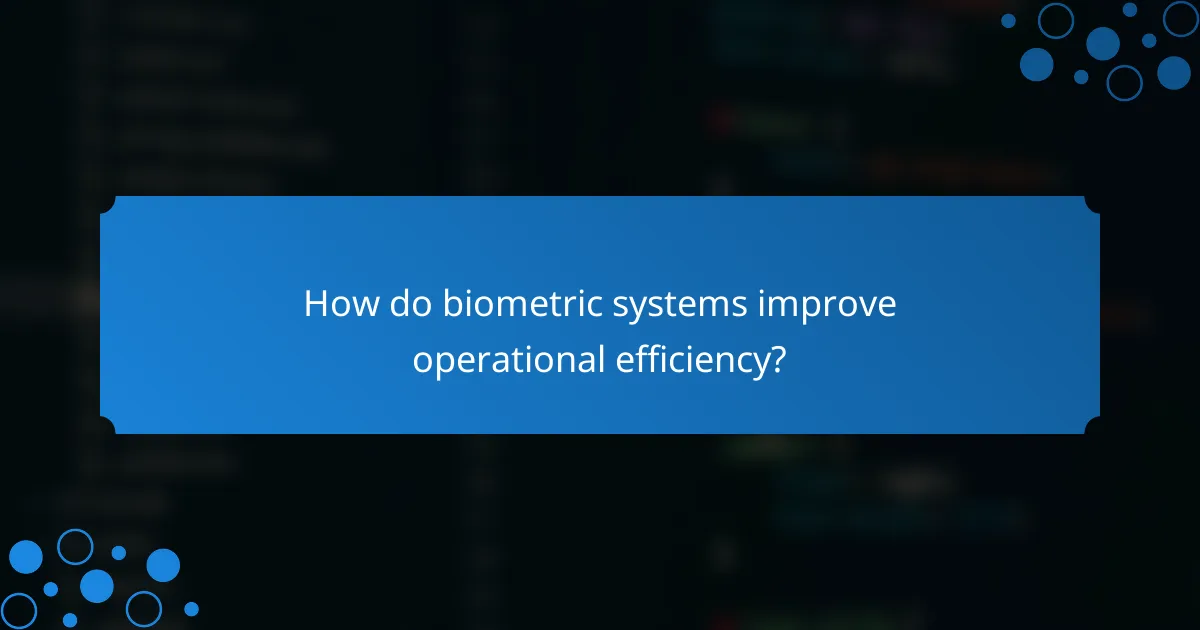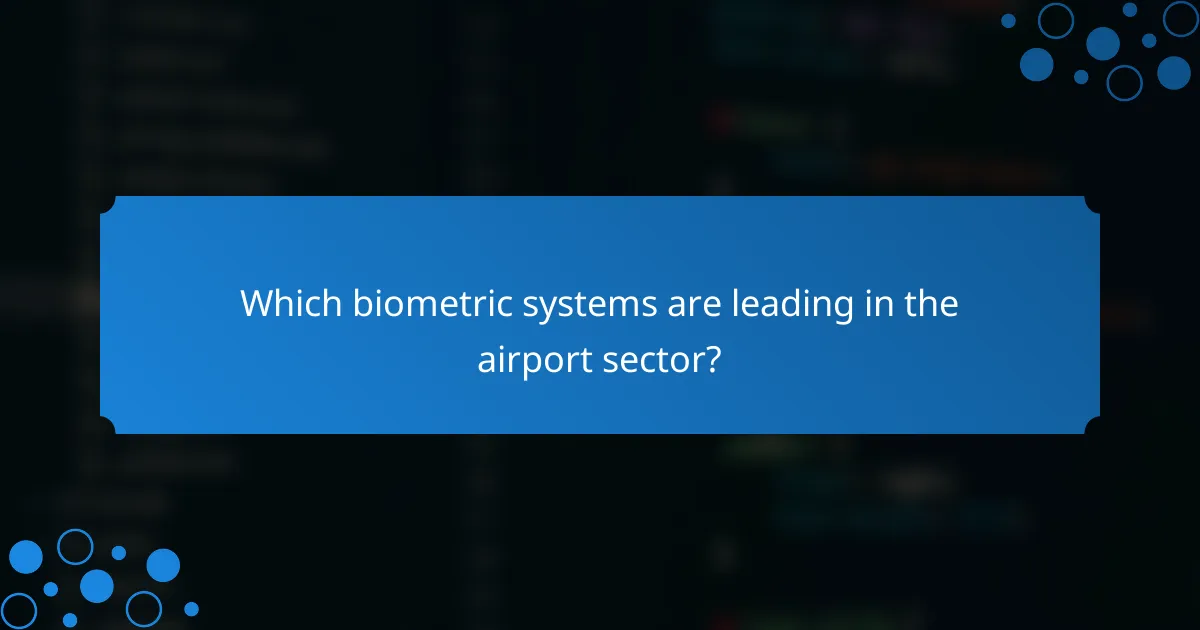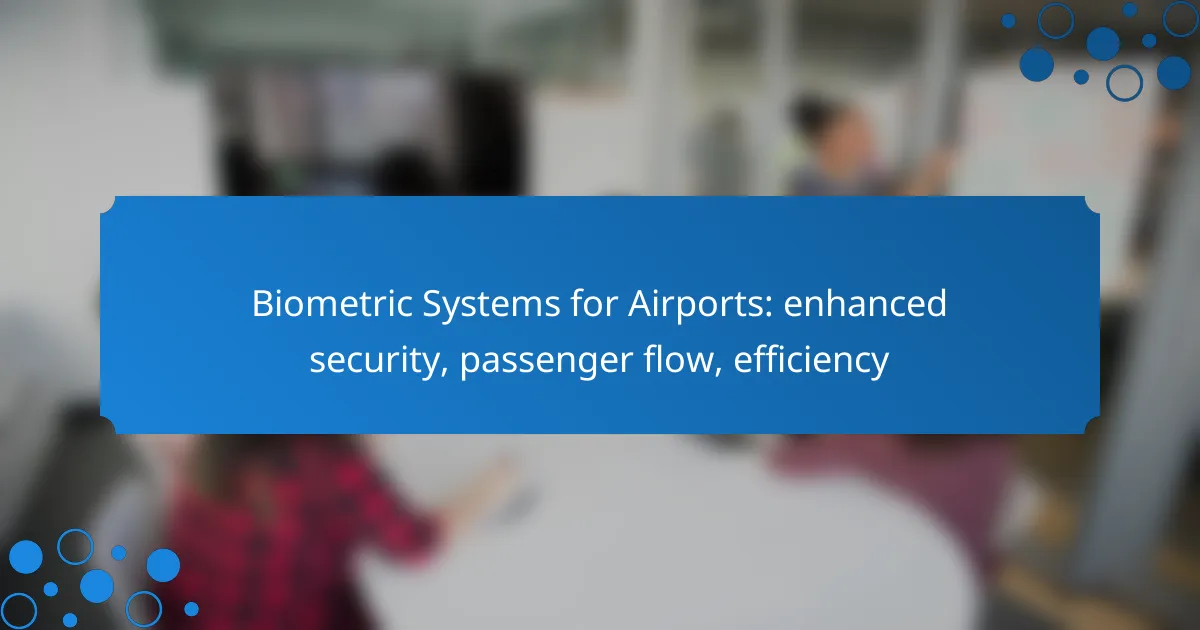Biometric systems are revolutionizing airport security by providing accurate identification and verification of passengers, which minimizes unauthorized access and potential threats. By automating identity verification processes, these systems enhance passenger flow and operational efficiency, allowing for quicker transitions through checkpoints and reduced wait times.

How do biometric systems enhance airport security in Canada?
Biometric systems significantly enhance airport security in Canada by providing accurate identification and verification of passengers, thereby reducing the risk of unauthorized access and potential threats. These systems streamline processes, allowing for faster and more secure passenger flow through various checkpoints.
Facial recognition technology
Facial recognition technology captures and analyzes facial features to identify individuals quickly. In Canadian airports, this technology is often used at boarding gates and security checkpoints to match passengers with their travel documents, enhancing security while expediting the boarding process.
One key consideration is the accuracy of the system, which can vary based on lighting conditions and angle of capture. Regular updates to the software and databases help maintain high accuracy rates, often exceeding 90% in optimal conditions.
Fingerprint scanning
Fingerprint scanning involves capturing the unique patterns of an individual’s fingerprints to confirm identity. This method is widely used in Canadian airports for both security checks and immigration processing, providing a reliable means of verifying passenger identities.
While fingerprint scanners are generally quick, they can be affected by factors such as skin condition or cleanliness. Ensuring that scanners are regularly maintained and that passengers are aware of how to properly use them can help mitigate these issues.
Iris recognition systems
Iris recognition systems analyze the unique patterns in the colored part of the eye to identify individuals. This technology is gaining traction in Canadian airports due to its high accuracy and low false acceptance rates, making it a robust option for enhancing security.
These systems typically require passengers to look into a camera for a brief moment, which can be completed in seconds. However, privacy concerns may arise, so transparent communication about data usage and storage is essential to maintain public trust.
Real-time threat detection
Real-time threat detection systems utilize biometric data alongside other security measures to identify potential threats as they occur. In Canadian airports, these systems can analyze passenger behavior and biometric signals to flag unusual activities for further investigation.
Integrating real-time data analysis with existing security protocols allows for quicker responses to potential threats, enhancing overall airport safety. Regular training for security personnel on interpreting alerts is crucial for effective implementation.
Integration with law enforcement databases
Integrating biometric systems with law enforcement databases allows airport security to cross-reference passenger identities against criminal records or watchlists. This capability is vital for identifying individuals who may pose a security risk before they board a flight.
In Canada, such integrations must comply with privacy laws and regulations, ensuring that data is handled responsibly. Regular audits and updates to the databases help maintain their effectiveness and accuracy, contributing to a safer travel environment.

What are the benefits of biometric systems for passenger flow?
Biometric systems significantly enhance passenger flow by automating identity verification processes, leading to quicker transitions through airport checkpoints. These systems utilize unique physical traits, such as fingerprints or facial recognition, to streamline operations and improve overall efficiency.
Reduced wait times
Biometric systems can drastically reduce wait times at security and boarding gates. By automating identity checks, passengers can move through these areas in a matter of seconds, often cutting down the typical wait time to just a few minutes. This efficiency is particularly beneficial during peak travel seasons when airports experience high volumes of passengers.
Streamlined boarding processes
With biometric boarding, airlines can enhance the boarding experience by allowing passengers to board using facial recognition technology. This method eliminates the need for physical boarding passes, reducing congestion at the gate. Passengers simply approach the boarding area, and the system verifies their identity, allowing for a smoother and faster boarding process.
Automated check-in kiosks
Biometric-enabled check-in kiosks allow passengers to check in without the need for staff assistance. By scanning their biometrics, travelers can confirm their identity and receive boarding passes quickly. This automation not only speeds up the check-in process but also frees up airline staff to assist passengers with more complex needs.
Enhanced passenger experience
The implementation of biometric systems contributes to an overall enhanced passenger experience by minimizing delays and reducing stress. Travelers enjoy a more seamless journey through the airport, which can lead to higher satisfaction rates. Additionally, the increased security measures provided by biometrics offer peace of mind, knowing that their identity is being protected effectively.

How do biometric systems improve operational efficiency?
Biometric systems enhance operational efficiency in airports by streamlining passenger identification and processing, reducing wait times, and improving overall throughput. These systems utilize unique biological traits, such as fingerprints or facial recognition, to facilitate faster and more secure passenger flow.
Data analytics for crowd management
Biometric systems generate valuable data that can be analyzed to manage crowd dynamics effectively. By tracking passenger movement and flow patterns, airports can identify peak times and adjust staffing accordingly. This proactive approach helps minimize congestion and enhances the travel experience.
For example, if data indicates a surge in passenger arrivals during certain hours, airports can deploy additional resources to those areas, ensuring smoother transitions through security and boarding processes.
Resource allocation optimization
With real-time data from biometric systems, airports can optimize resource allocation to meet fluctuating demands. This includes adjusting the number of security personnel or check-in kiosks based on passenger volume. Efficient resource allocation not only improves operational efficiency but also reduces operational costs.
Airports can use predictive analytics to forecast busy periods, allowing them to prepare in advance and allocate resources where they are most needed, thus maintaining a high level of service without unnecessary expenditure.
Integration with airport management software
Integrating biometric systems with existing airport management software creates a cohesive operational environment. This integration allows for seamless data sharing across different departments, enhancing communication and coordination. For instance, check-in, security, and boarding processes can be synchronized to ensure a smooth passenger journey.
Moreover, such integration can facilitate automated reporting and compliance with regulations, ensuring that airports meet security standards while maintaining efficiency. This holistic approach to airport management can significantly enhance the passenger experience and operational performance.

What are the key considerations for implementing biometric systems?
Implementing biometric systems in airports requires careful attention to regulatory compliance, data privacy, and system interoperability. These factors are crucial for ensuring the systems enhance security while maintaining passenger flow and efficiency.
Regulatory compliance
Regulatory compliance is essential when deploying biometric systems in airports, as these systems must adhere to local and international laws regarding data collection and usage. Regulations such as the General Data Protection Regulation (GDPR) in Europe set strict guidelines on how personal data can be processed.
Airports should conduct thorough assessments to ensure that their biometric systems align with relevant regulations. This may involve consulting legal experts and engaging with regulatory bodies to understand the specific requirements for biometric data handling.
Data privacy concerns
Data privacy is a significant concern when implementing biometric systems, as these technologies collect sensitive personal information. Airports must ensure that they have robust data protection measures in place to safeguard passenger data from unauthorized access and breaches.
Transparency is key; airports should inform passengers about how their biometric data will be used, stored, and protected. Implementing strong encryption and access controls can help mitigate risks and build trust with travelers.
System interoperability
System interoperability is critical for the seamless integration of biometric systems with existing airport infrastructure. Biometric solutions must be compatible with various systems, including check-in, security, and boarding processes, to enhance overall efficiency.
Airports should prioritize selecting biometric technologies that adhere to industry standards and can easily integrate with other systems. Conducting pilot tests can help identify potential integration issues before full-scale implementation, ensuring a smoother transition and improved passenger experience.

Which biometric systems are leading in the airport sector?
Several biometric systems are at the forefront of enhancing security, passenger flow, and efficiency in airports. These systems utilize advanced technologies such as facial recognition, fingerprint scanning, and iris detection to streamline processes while ensuring safety.
Clearview AI
Clearview AI specializes in facial recognition technology, which is increasingly being adopted in airport security. Its system allows for rapid identification of individuals by matching faces against a vast database of images, providing quick verification for security personnel.
While effective, airports must consider privacy implications and compliance with local regulations regarding data usage. Clearview AI’s technology can significantly reduce wait times but requires careful management of data security and ethical concerns.
Gemalto
Gemalto, now part of Thales Group, offers biometric solutions that integrate seamlessly into existing airport systems. Their biometric kiosks and gates utilize fingerprint and facial recognition to expedite passenger processing, enhancing both security and efficiency.
Airports using Gemalto’s systems report improved passenger flow, with processing times reduced to mere seconds. However, proper training for staff and maintenance of the technology are essential to maximize effectiveness and minimize downtime.
NEC Corporation
NEC Corporation provides a range of biometric technologies, including facial recognition and fingerprint scanning, tailored for airport environments. Their systems are known for high accuracy and speed, enabling quick identification of travelers at various checkpoints.
NEC’s solutions are particularly beneficial for managing large crowds during peak travel times. Airports should ensure that these systems are regularly updated and integrated with other security measures to maintain optimal performance.
Thales Group
Thales Group offers comprehensive biometric solutions that enhance airport security and passenger experience. Their systems include facial recognition and identity management tools designed to streamline passenger verification processes.
With Thales, airports can implement multi-modal biometric systems that combine various identification methods for increased accuracy. It is crucial for airport operators to stay informed about the latest technological advancements and regulatory requirements to fully leverage these systems.
